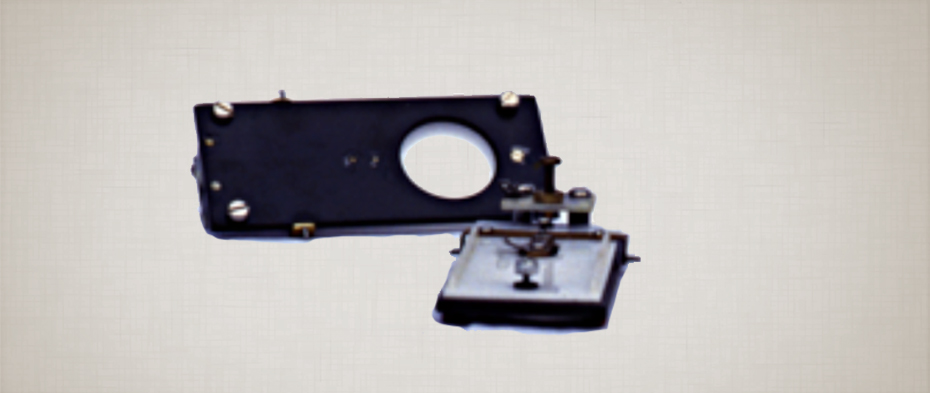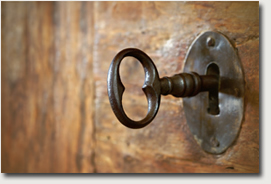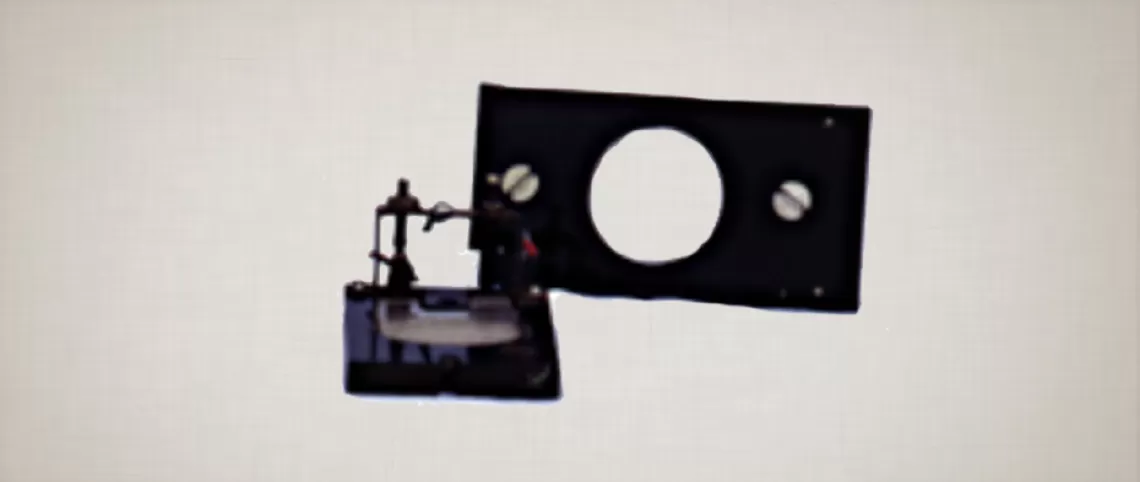
Harvard Pigeon Key (1957)
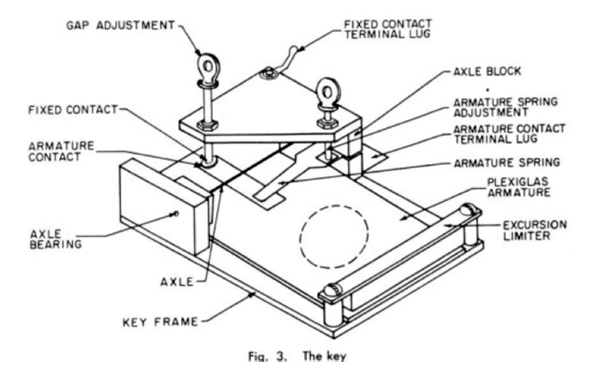 This device is a simple electrical switch capable of recording up to several pigeon key pecks (with its beak) a second with great accuracy. A diagram of a key, taken from Ferster and Skinner’s Schedules of Reinforcement (1957, Appleton-Century-Crofts, page 16), is shown and a photograph of an actual key fabricated in the Harvard instrument shop. The actual key differs slightly from the diagram in that the 5-sided cover in the diagram supporting the “gap adjustment” screw is replaced in the keys shown in the photograph by a solid metal bar running across the width of the back of the key.
This device is a simple electrical switch capable of recording up to several pigeon key pecks (with its beak) a second with great accuracy. A diagram of a key, taken from Ferster and Skinner’s Schedules of Reinforcement (1957, Appleton-Century-Crofts, page 16), is shown and a photograph of an actual key fabricated in the Harvard instrument shop. The actual key differs slightly from the diagram in that the 5-sided cover in the diagram supporting the “gap adjustment” screw is replaced in the keys shown in the photograph by a solid metal bar running across the width of the back of the key.
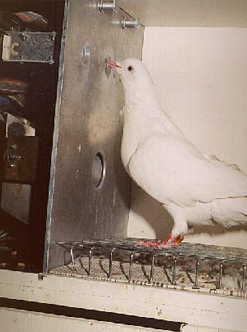 The black part of the key allowed it to be attached with screws to a metal “work panel” such that the brighter plastic circle was accessible to be pecked by the pigeon, which stood in front of the panel. The key was recessed from the front by the depth of the work panel. In this example of the pigeon key, the plastic circle is translucent, allowing it to be transilluminated (lit from behind) uniformly by one or more low-wattage light bulbs that served as the discriminative stimulus or stimuli. In other versions of the key, the plastic was clear, allowing images to be projected on a small screen behind the key using a multiple stimulus projector.
The black part of the key allowed it to be attached with screws to a metal “work panel” such that the brighter plastic circle was accessible to be pecked by the pigeon, which stood in front of the panel. The key was recessed from the front by the depth of the work panel. In this example of the pigeon key, the plastic circle is translucent, allowing it to be transilluminated (lit from behind) uniformly by one or more low-wattage light bulbs that served as the discriminative stimulus or stimuli. In other versions of the key, the plastic was clear, allowing images to be projected on a small screen behind the key using a multiple stimulus projector.
A pigeon pecking a key is shown in the photograph on the right. Pecks activated a switch that allowed discrete responses to be recorded. Its high accuracy at high rates of pecking was possible because the key operated on the “break” of the switch, rather than on its “make.”
General Activity Recorder (1984)
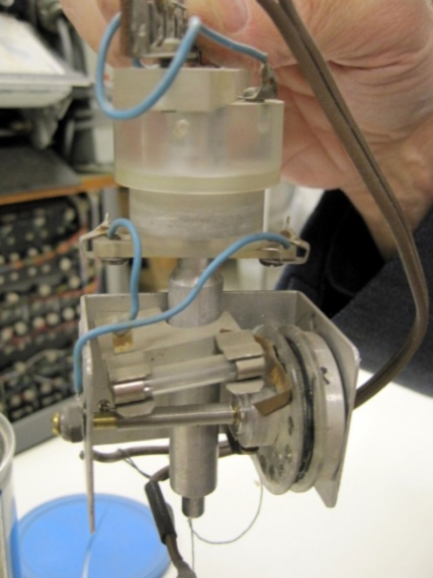 This device attaches via the string shown at its bottom to a small connector attached to the scalp of a pigeon. The device, described in detail by Hake, Enoch, and Kelly (1971), is constructed with a series of springs and pulleys such that the string extends and contracts from the device as the pigeon moves around the operant chamber. Each movement is detected by a mercury-filled commutator that allows current to pass through it as the pigeon moves around. The movements are converted from analogue, continuous, activity to a series of digital pulses recorded as a number count of the movements. With a device like this it is possible to define activity precisely and use it as an operant. This device was used by Buzzard and Hake (1984) to study how activity changes when food delivery and its absence were correlated with different stimuli – a discrimination task. In general, the pigeons were active when food delivery was possible but not in its absence.
This device attaches via the string shown at its bottom to a small connector attached to the scalp of a pigeon. The device, described in detail by Hake, Enoch, and Kelly (1971), is constructed with a series of springs and pulleys such that the string extends and contracts from the device as the pigeon moves around the operant chamber. Each movement is detected by a mercury-filled commutator that allows current to pass through it as the pigeon moves around. The movements are converted from analogue, continuous, activity to a series of digital pulses recorded as a number count of the movements. With a device like this it is possible to define activity precisely and use it as an operant. This device was used by Buzzard and Hake (1984) to study how activity changes when food delivery and its absence were correlated with different stimuli – a discrimination task. In general, the pigeons were active when food delivery was possible but not in its absence.
This apparatus was a precursor of contemporary devices using wireless technology to measure activity in children. They prove useful for not only monitoring movements of children prone to elope, but also for measuring time spent at various work and play stations as an index of preference and time allocation between different activities.
Gerbrands 1-Inch Diameter Pigeon Key (1950-1994)
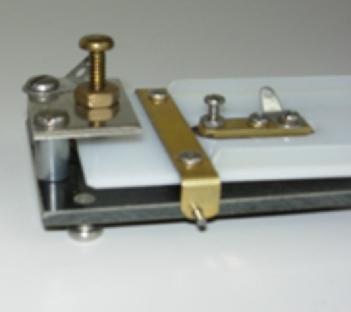 This response key was manufactured with only minor changes over the years between 1950 and 1994, when the Gerbrands Company ceased operations. It was, and is, regarded as the best key available in terms of both reliability and durability. Many of these manufactured in the 1950s are still in use in the second decade of the 21st century. The lower photograph shows the force adjustment mechanism in greater detail. The same style key also came in a ¾ inch diameter version that was the more widely used of the two. The details of its appearance and operation are as described for the Harvard Pigeon Key also on display in this room.
This response key was manufactured with only minor changes over the years between 1950 and 1994, when the Gerbrands Company ceased operations. It was, and is, regarded as the best key available in terms of both reliability and durability. Many of these manufactured in the 1950s are still in use in the second decade of the 21st century. The lower photograph shows the force adjustment mechanism in greater detail. The same style key also came in a ¾ inch diameter version that was the more widely used of the two. The details of its appearance and operation are as described for the Harvard Pigeon Key also on display in this room.
